
Central African Republic
Country Flag Details
four equal horizontal bands of blue (top), white, green, and yellow with a vertical red band in center; a yellow five-pointed star to the hoist side of the blue band; banner combines the Pan-African and French flag colors; red symbolizes the blood spilled in the struggle for independence, blue represents the sky and freedom, white peace and dignity, green hope and faith, and yellow tolerance; the star represents aspiration towards a vibrant future.
Background
The French colony of Ubangi-Shari became the Central African Republic upon independence in 1960. After three tumultuous decades of misrule — mostly by military governments — civilian rule was established in 1993 but lasted only a decade. Peace agreements between the government and armed factions have had little effect, and armed groups operate openly.

Geography
Area
total : 622,984 sq km
land: 622,984 sq km
water: 0 sq km
Climate
tropical; hot, dry winters; mild to hot, wet summers
Natural resources
diamonds, uranium, timber, gold, oil, hydropower
People and Society
Population
total: 5,650,957
Ethnic groups
Baya 28.8%, Banda 22.9%, Mandjia 9.9%, Sara 7.9%, M’Baka-Bantu 7.9%, Arab-Fulani (Peuhl) 6%, Mbum 6%, Ngbanki 5.5%, Zande-Nzakara 3%, other Central African Republic ethnic groups 2%, non-Central African Republic ethnic groups .1% (2003 est.)
Languages
French (official), Sangho (lingua franca and national language), tribal languages
Religions
Roman Catholic 34.6%, Protestant 15.7%, other Christian 22.9%, Muslim 13.8%, ethnic religionist 12%, Baha’i 0.2%, agnostic/atheist 0.7% (2020 est.)
Population growth rate
1.76% (2024 est.)
Government
Government type
presidential republic
Capital name: Bangui
Executive branch
chief of state: President Faustin-Archange TOUADÉRA (since 30 March 2016)
head of government: Prime Minister Félix MOLOUA (since 7 February 2022)
Economy
Real GDP (purchasing power parity)
$5.849 billion (2023 est.)
$5.798 billion (2022 est.)
$5.769 billion (2021 est.)
Real GDP per capita
$1,100 (2023 est.)
$1,100 (2022 est.)
$1,100 (2021 est.)
Exports
$293.074 million (2022 est.)
$332.869 million (2021 est.)
$353.021 million (2020 est.)
Exports – partners
UAE 54%, China 14%, France 6%, Turkey 5%, Belgium 4% (2023)
Exports – commodities
gold, wood, diamonds, vehicle parts/accessories, cotton (2023)
Imports
$784.669 million (2022 est.)
$778.395 million (2021 est.)
$799.195 million (2020 est.)
Imports – partners
China 16%, Cameroon 14%, France 8%, Belgium 6%, Cote d’Ivoire 5% (2023)
Imports – commodities
refined petroleum, cars, packaged medicine, vaccines, tanks and armored vehicles (2023)

Export structure by product groups in 2023 (% of total export) (UNCTAD)
The export structure of a country involves the range, composition, and value of goods and services traded on the international market, which provides vital insights into the nation’s economic health, global competitiveness, and overall developmental stage. In the case of the Central African Republic, the export profile is predominantly influenced by key commodities such as gold, diamonds, and timber, reflecting a narrow reliance on a few sectors. To promote sustainable economic growth and resilience in the face of global market fluctuations, it is essential to confront the various challenges that affect these industries while simultaneously pursuing a comprehensive strategy to diversify the export base, thus fostering a more robust and varied economy that can better withstand external shocks.

Poverty and vulnerable employment in Central African Republic (World Bank)
Vulnerable employment refers to work situations where individuals experience not only insufficient job security but also unreasonably low wages and limited access to essential social protections such as health insurance, pensions, and basic labor rights. This group prominently includes Own-Account Workers, who strive to support themselves through self-employment without hired assistance, like street vendors and small-scale farmers, as well as Contributing Family Workers, who contribute their labor to family enterprises or farms without formal payment. Alarmingly, in 2023, 93 percent of total employment in the Central African Republic was found in the informal sector. These types of employment are often characterized by informality and instability, making workers especially vulnerable to economic downturns, exploitation, and the harsh challenges of persistent poverty.
Understanding the significance of poverty level at $2.15 per day
In 2021, nearly 4 million people in the Central African Republic lived in poverty at $2.15 per day.
The poverty level at $2.15 per day (measured in 2017 purchasing power parity, or PPP) is a key global benchmark used by the World Bank to define extreme poverty in low-income countries. It indicates:
1. Basic Survival Threshold
• People living below $2.15 per day struggle to afford essential needs such as food, clean water, shelter, healthcare, and education.
2. Economic Underdevelopment
• A high percentage of a country’s population living below this threshold suggests low economic productivity, high unemployment, and weak social safety nets.
3. Inequality and Social Vulnerability
• It reflects deep income inequality and a lack of access to opportunities for upward mobility.
• People in this category are more vulnerable to shocks like food price increases, climate disasters, or health crises.
4. Policy Challenges
• Governments need targeted interventions such as social welfare programs, job creation, and improved access to education and healthcare to reduce poverty.
A country's export structure is a reflection of its level of development and productive capacities
The export structure of a country refers to the composition, diversity, and value of the goods and services it sells to other countries. It provides key insights into the country’s economic health, competitiveness, and level of development. Productive capacities of a country refer to its ability to produce goods and services efficiently and sustainably over time. These capacities are shaped by various factors, including human capital, natural resources, infrastructure, private sector, development, technology & innovation, institutions & governance, financial systems trade & market access.
Here’s what the export structure and productive capacities of a country typically indicate:
- Level of Economic Development
- Developed economies usually export high-value manufactured goods, technology, and services.
- Developing economies often rely on raw materials, agricultural products, or low-value manufactured goods.
- Industrial and Sectoral Strengths
- A strong presence of high-tech or industrial goods (e.g., machinery, electronics) suggests a well-developed manufacturing sector.
- A dominance of commodities (e.g., oil, minerals, agricultural products) indicates reliance on natural resources.
- Export Diversification
- A diverse export base (multiple industries) makes a country’s economy more stable and resilient to global price shocks.
- A concentrated export base (few key products) makes it vulnerable to market fluctuations.
- Trade Partnerships and Dependence
- If exports are heavily dependent on a single country or region, the economy is more exposed to geopolitical and trade risks.
- A wide range of trading partners indicates stronger global integration.
- Competitiveness and Value Addition
- Exporting mainly raw materials (e.g., crude oil instead of refined petroleum) suggests limited industrial processing capacity.
- A high share of finished and high-tech goods suggests strong value addition and competitiveness.
Central African Republic (CAR)-Sanitation
Central African Rep – Proportion of population served with at least basic sanitation
In 2022, the proportion of the population served with at least basic sanitation for CAR was 13.8%. Proportion of population served with at least basic sanitation of CAR declined from 20.6 % in 2000 to 13.8% in 2022, an absolute change of 6.8 percentage points (pp) decrease between 2000 and 2022.
Central African Republic – Proportion of urban population served with at least basic sanitation
In 2022, the proportion of the urban population served with at least basic sanitation for CAR was 39.2 %. The proportion of the urban population served with at least basic sanitation in CAR declined from 39.2 % in 2000 to 24.5 % in 2022, an absolute change of 14.7 pp decrease between 2000 and 2022.
Central African Republic – Proportion of rural population served with at least basic sanitation
In 2022, the proportion of rural population served with at least basic sanitation for CAR was 5.7 %. Proportion of rural population served with at least basic sanitation of CAR fell gradually from 9.4 % in 2000 to 5.7 % in 2022, an absolute change of 3.7 pp decrease between 2000 and 2022.
Central African Republic – Proportion of population with at least Basic Sanitation Access: A Global Perspective
In 2022, a mere 13.8% of the population in the Central African Republic had access to at least basic sanitation, a significant drop from 20.6% in 2000, revealing a disturbing trend. In sharp contrast, countries such as China, Indonesia, Sri Lanka, Thailand, and Vietnam achieved much higher access rates, with figures reaching 95.9%, 88.2%, 95.1%, and 99.0%, respectively. Access to safe sanitation is not merely a statistic; it represents a fundamental human right essential for health, dignity, and overall well-being. These alarming figures highlight the urgent need for collective action to develop sustainable and inclusive solutions that guarantee safe sanitation for every person across Sub-Saharan Africa. United, we can foster healthier, more resilient communities and create a pathway to a brighter future.
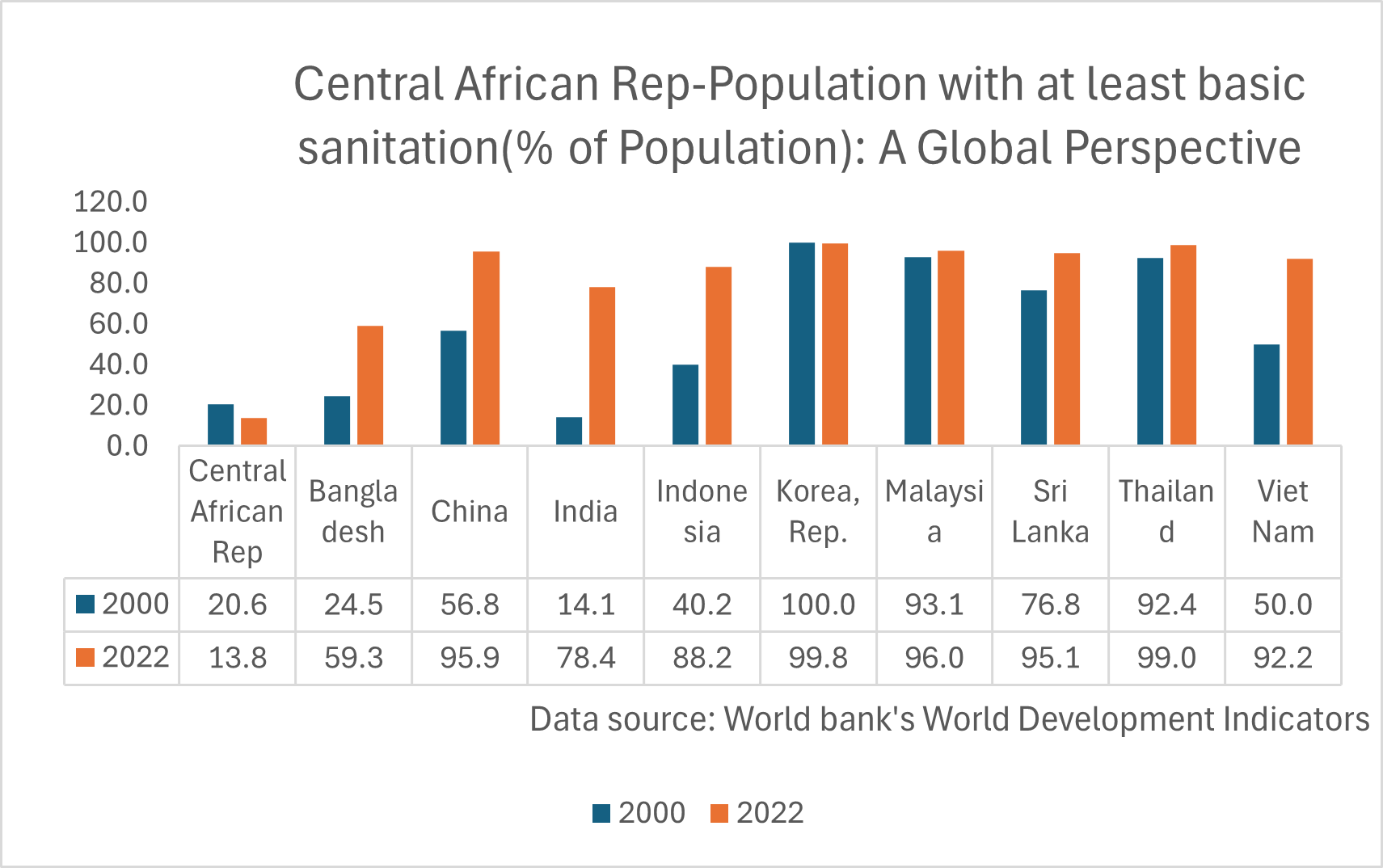
Central African Republic- share of the rural population with at least basic sanitation services: A Global Perspective
Unsafe sanitation is a silent crisis that claims countless lives each year, underscoring the urgent need for safe sanitation as a fundamental human right. In 2022, only 5.7% of the rural population in the Central African Republic had access to basic sanitation services, a troubling decline from 9.4% in 2000 that calls for our collective action. In contrast, Thailand and Sri Lanka demonstrate what is achievable, with 98.4% and 94.9% of their rural populations benefiting from sanitation facilities in 2022. Let us reflect on these figures and work towards a future where everyone can enjoy the dignity of safe sanitation.
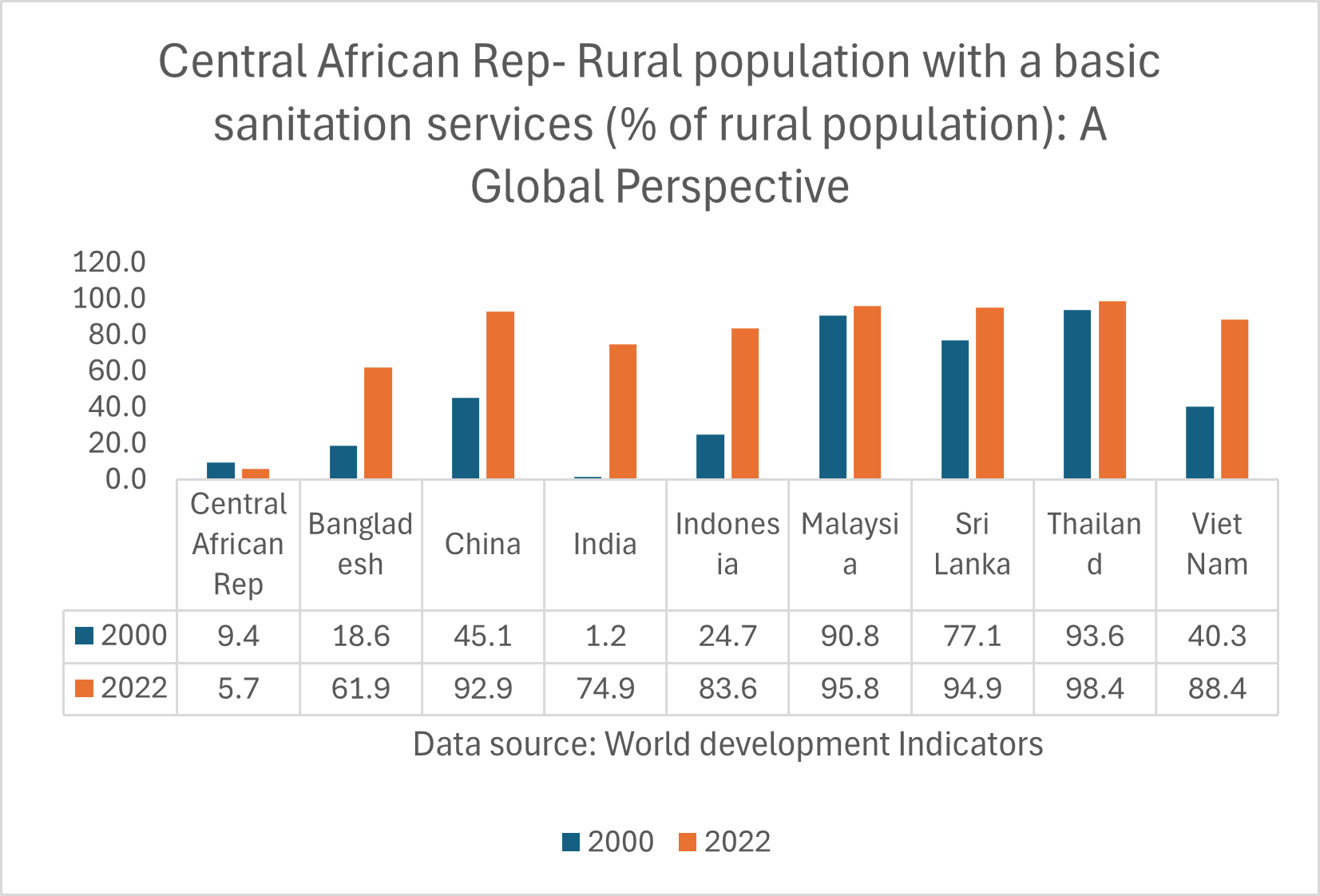
Central African Republic-Water Supply
Central African Republic – Proportion of total population served with at least basic water
In 2022, the proportion of the population served with at least basic water for CAR was 36.3 %. Proportion of population served with at least basic water of CAR decreased from 59.0 % in 2000 to 36.3 % in 2022 , an absolute change of 22.7 pp decrease between 2000 and 2022.
Central African Republic – Proportion of urban population served with at least basic water
In 2022, the proportion of the urban population served with at least basic water for CAR was 48.1 %. The proportion of the urban population served with at least basic water in CAR fell gradually from 83.6 % in 2000 to 48.1 % in 2022, an absolute change of 35.5 pp between 2000 and 2022.
Central African Republic – Proportion of rural population with at least basic water
In 2022, the proportion of the rural population served with at least basic water for CAR was 27.4 %. Proportion of rural population served with at least basic water of CAR declined from 44.4 % in 2000 to 27.4 % in 2022, an absolute change of 17 pp decrease between 2000 and 2022.
Central African Republic – Proportion of total population served with at least basic drinking water services: A Global Perspective
In 2022, it was reported that only 36.3 % of the population in the Central African Republic had access to at least basic water services. This is a troubling decline from 59.0% in 2000, highlighting a growing crisis that affects countless lives. In stark contrast, countries like South Korea and Thailand enjoy the assurance of 100% access to safe drinking water. These figures are not merely numbers; they reflect the daily struggles faced by communities, impacting their health, education, and overall well-being. It is essential for us to acknowledge these disparities and unite in our efforts to advocate for sustainable solutions and effective governance. Every individual deserves access to this vital resource, and together, we can work towards a future where clean water is a reality for all.
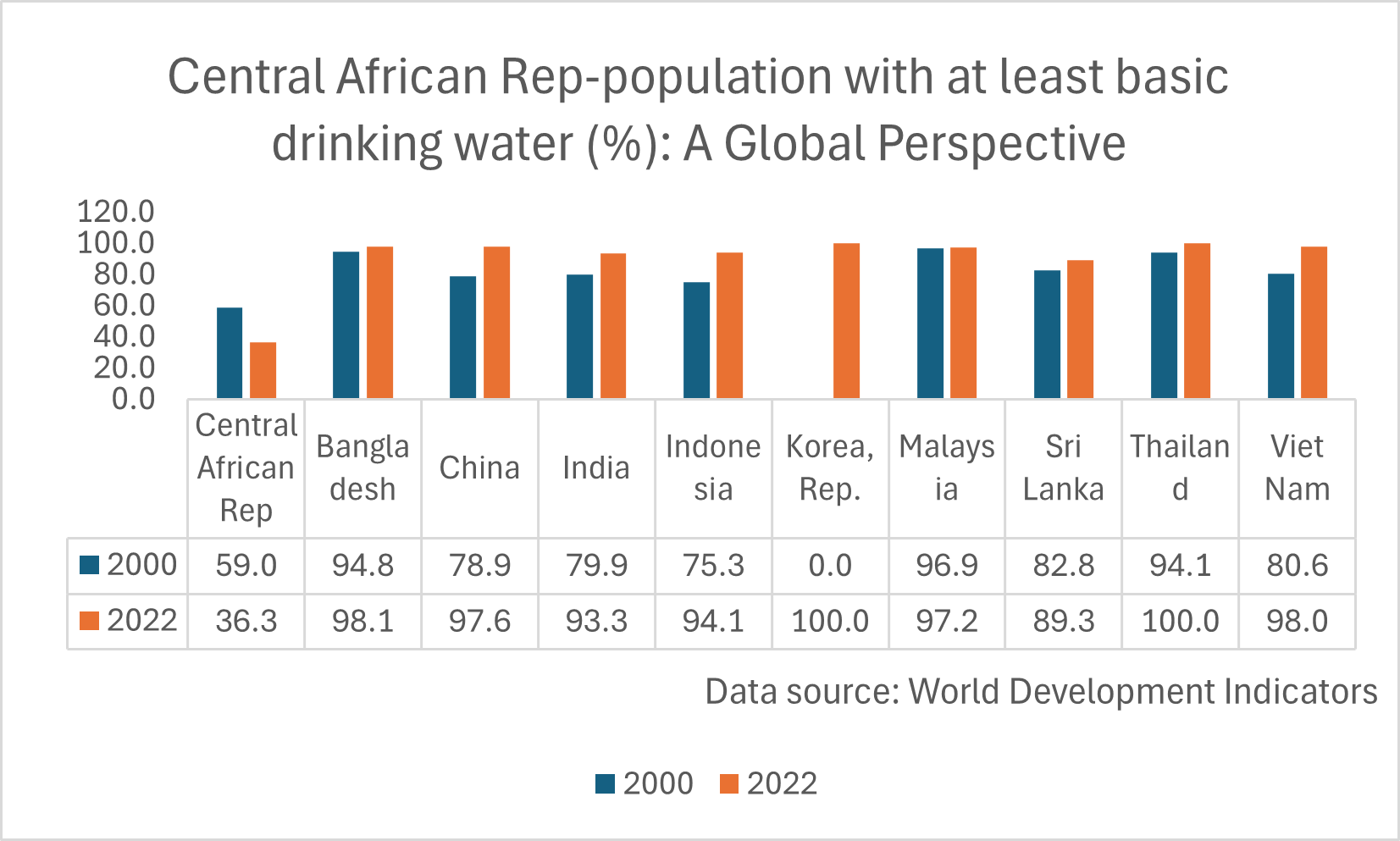
Central African Republic – Proportion of rural population with access to basic drinking water services: A Global Perspective.
In 2022, only 27.4% of the rural population in the Central African Republic had access to at least basic water services. This represents a troubling decline from 44.4% in the year 2000. In stark contrast, countries such as Bangladesh, Thailand, and Vietnam reported access rates of 98.3%, 100%, and 97.2%, respectively, in 2022. Access to safe drinking water is not merely a basic necessity; it is a fundamental human right that must be upheld for all individuals. It is crucial to highlight the need for sustainable governance that ensures the long-term availability of this vital resource by fostering collaborative partnerships among local communities, government entities, and international organizations. Together, we must work towards a future where every rural resident has reliable access to safe drinking water. It is our shared responsibility to support initiatives that not only address current challenges but also establish a foundation for a more sustainable and equitable water future for all.
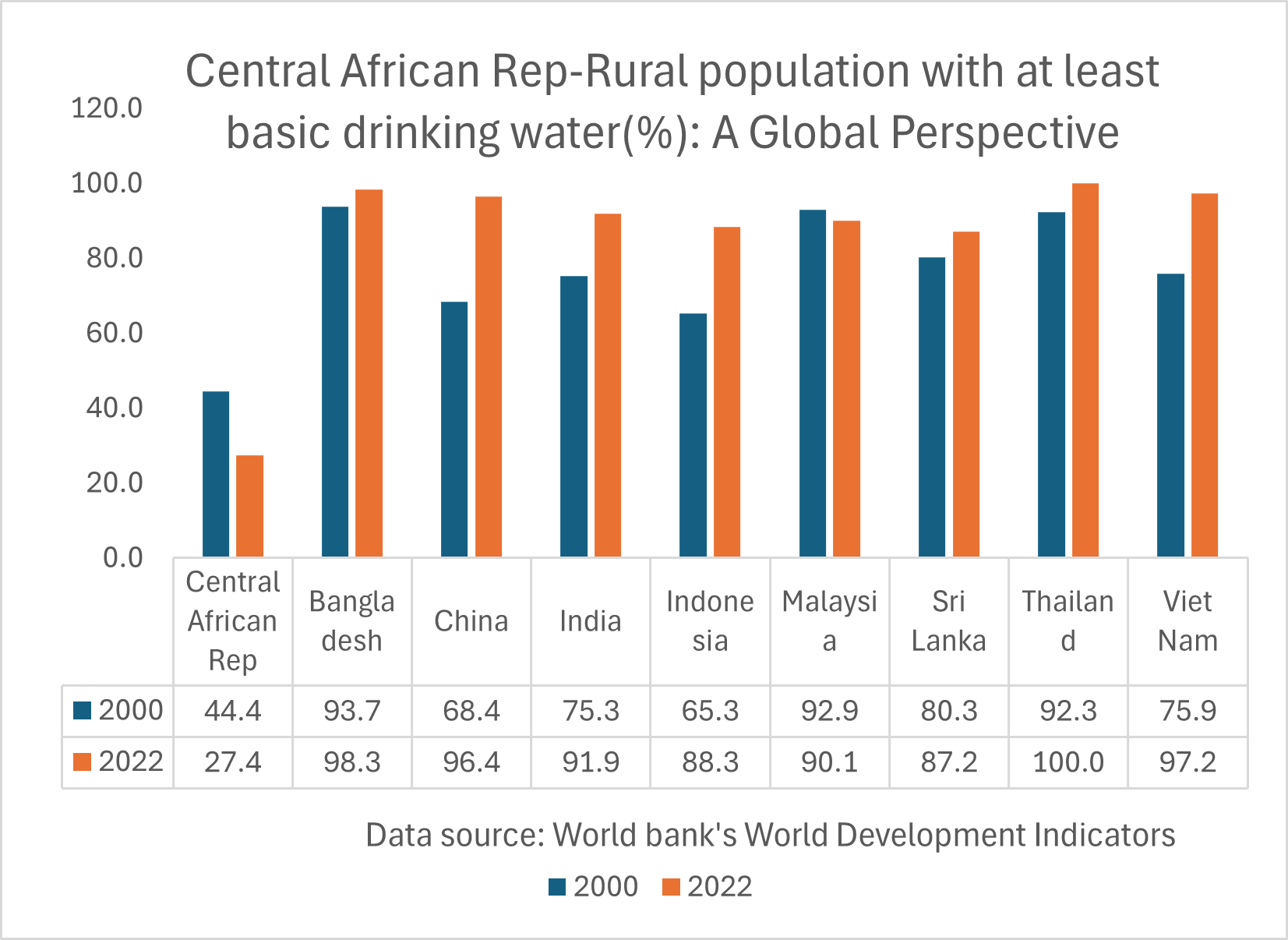
Central African Republic- Access to Electricity
Central African Republic- Access to Electricity (% of population)
In 2022, the proportion of the population with access to electricity for CAR was 15.7 %. The proportion of population with access to electricity of CAR increased from 6% in 2000 to 15.7 % in 2022, an absolute change of 9.7 pp increase between 2000 and 2022.
Central African Republic-Access to Electricity (% urban population)
In 2022, the proportion of the urban population with access to electricity in CAR was 42.2%.The proportion of the urban population with access to electricity in CAR declined from 47.8% % in 2000 to 42.2% in 2022, an absolute change of 5.6 pp between between 2000 and 2022.
Cameroon-Access to Electricity (% rural population)
In 2022, the proportion of the rural population with access to electricity in CAR was 1.6 %. The proportion of the rural population with access to electricity in CAR decreased from 2.0 % in 2020 to 1.6% in 2022, an absolute change of 1.4 pp between 2020 and 2022.
Central African Republic – Access to electricity (% of population)
In 2022, a staggering 84.3% of the population in the Central African Republic lacked access to electricity, with only 15.7% enjoying this essential resource. In comparison, countries such as Sri Lanka, Vietnam, China, and Indonesia reported 100 percent access to electricity in 2022. The global average stands at a remarkable 91.4%, highlighting the significant disparities in energy availability that not only impact daily living conditions but also stifle economic growth and development opportunities. The access to electricityis not just a matter of convenience; it is a fundamental right that can significantly elevate the quality of life for countless individuals and unlock immense potential for sustainable growth and development.
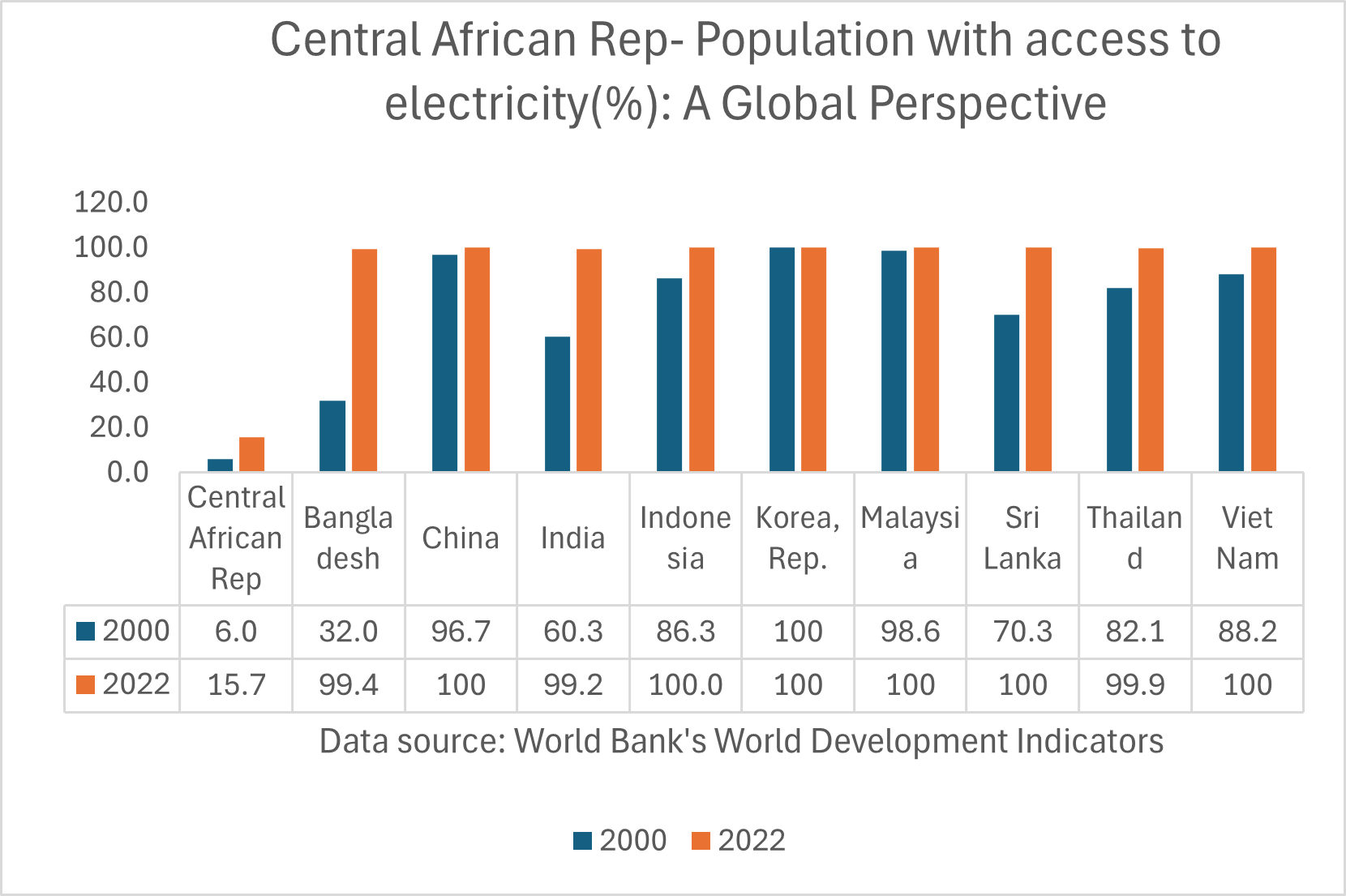
Central African Republic – Access to electricity (% of rural population)
As of 2022, a mere 1.6% of the rural population in the Central African Republic had access to electricity. This represents a troubling decline from 1.9% in 2020, highlighting a concerning shift of 0.3% over just two years. This stark reality places the Central African Republic far behind other countries like China, South Korea, Vietnam, and Sri Lanka, which reported 100 percent access to electricity for their rural population, highlighting the need for a fundamental change across Sub-Saharan Africa. Together, we can bridge this critical gap and empower communities, paving the way for a brighter and more sustainable future.
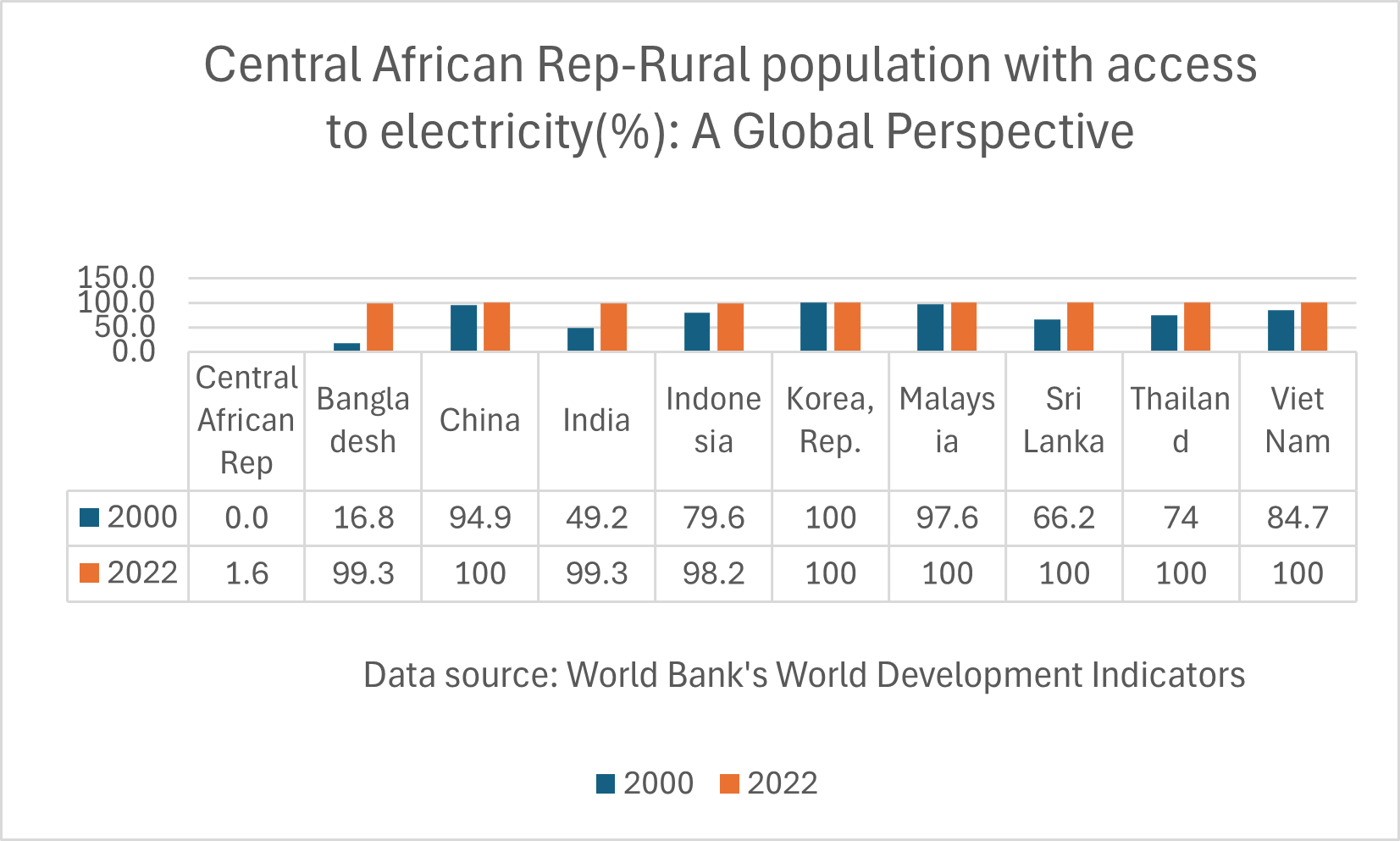
Central African Rep- Health Outcomes
Life Expectancy: A Global Perspective
The journey of life expectancy for newborns around the world has seen a remarkable rise, climbing from just 47 years in 1950 to an inspiring 71 years in 2021. However, this progress has not been uniform across the globe. In Sub-Saharan Africa, the strides have been more gradual, with the Central African Republic experiencing an increase from 39 years in 1960 to 54.5 years in 2022. In contrast, China has undergone a profound transformation, witnessing life expectancy soar from 33 years in 1960 to an impressive 79 years in 2022. We invite you to explore the accompanying chart below, where you can delve into the nuances and trends that set Sub-Saharan African countries apart from other developing countries.

Central African Republic – Under-Five Mortality Rate (per 1,000 live births): A Global Perspective
The under-five mortality rate reflects the likelihood that a newborn will not survive to age five, based on current statistics. In 2022, the Central African Republic recorded 96.8 deaths per 1,000 live births, a significant drop from 182.3 in 1980. Since 1950, global child mortality rates have improved dramatically due to better living conditions, healthcare, nutrition, and access to safe water. Regions like Europe and America have seen rates fall below 4 percent, while developing nations in South America, Asia, and North Africa have made progress, though challenges remain. For example, in 1980, the Central African Republic and Bangladesh had rates of 182.3 and 206 respectively, but by 2022, Bangladesh improved significantly to 29 while the Central African Republic remains at approximately 96.8.

Central African Republic – Maternal Mortality Ratio: A Global Perspective
In 2020, the Central African Republic reported a staggering 835 deaths per 100,000 live births, reflecting a notable decline from the alarming rate of 1315 in 2000; however, this figure remains exceedingly high and a cause for grave concern. In sharp contrast, countries such as China, Sri Lanka, and South Korea achieved much lower maternal mortality rates, with only 23, 29, and 8 deaths per 100,000 live births, respectively. This stark disparity underscores the urgent need to prioritize maternal health through immediate and effective action, emphasizing the enhancement of healthcare services, the provision of essential education, and the cultivation of strong community support systems for all women, ensuring that every mother has access to the care she needs.